Learn how to get rid of mealybugs on plants with natural methods best suited to your home environment. We all get pests on our houseplants sometimes. They find their way indoors and cause lots of problems. Let’s get mealybugs out of our houseplants. And keep them out.
What are Mealy bugs?
Mealybugs( planococcus citric) are small sucking insects. They originated from tropical parts of Asia and are now found worldwide. They draw sap from plant cells with their piercing mouthparts.
Like Spider mites, thrips and aphids, Mealy bugs will attack foliage, stems and flowers on plants.
Finding mealybugs on houseplants is a common problem for houseplant owners. Mealybugs are prevalent outdoors in warmer climates but are highly adaptable to indoor environments.
Mealybugs thrive in the constant warmth and humidity of commercial greenhouses. They can easily hitchhike into your home on newly purchased houseplants.
In this post, we teach you how to identify them, the plant damage they cause, and the methods to get them off your houseplants and out of your home.
What do mealy bugs look like?

Mealybugs look like little beetles that got caught in a blizzard. They live under a fuzzy looking protective white or grey coating. That white fuzzy coating is actually wax.
They are very small bugs. Although much larger than spider mites.
Mealy bugs are From 1/16th to 1/8 inch with an oblong body shape. The fuzzy waxy coating makes them easy to spot. They look like tiny puffs of cotton.
They can be seen singly or in colonies all grouped together. You might see them in several different life stages all at once in that cottony mass.
Mealybug Damage:
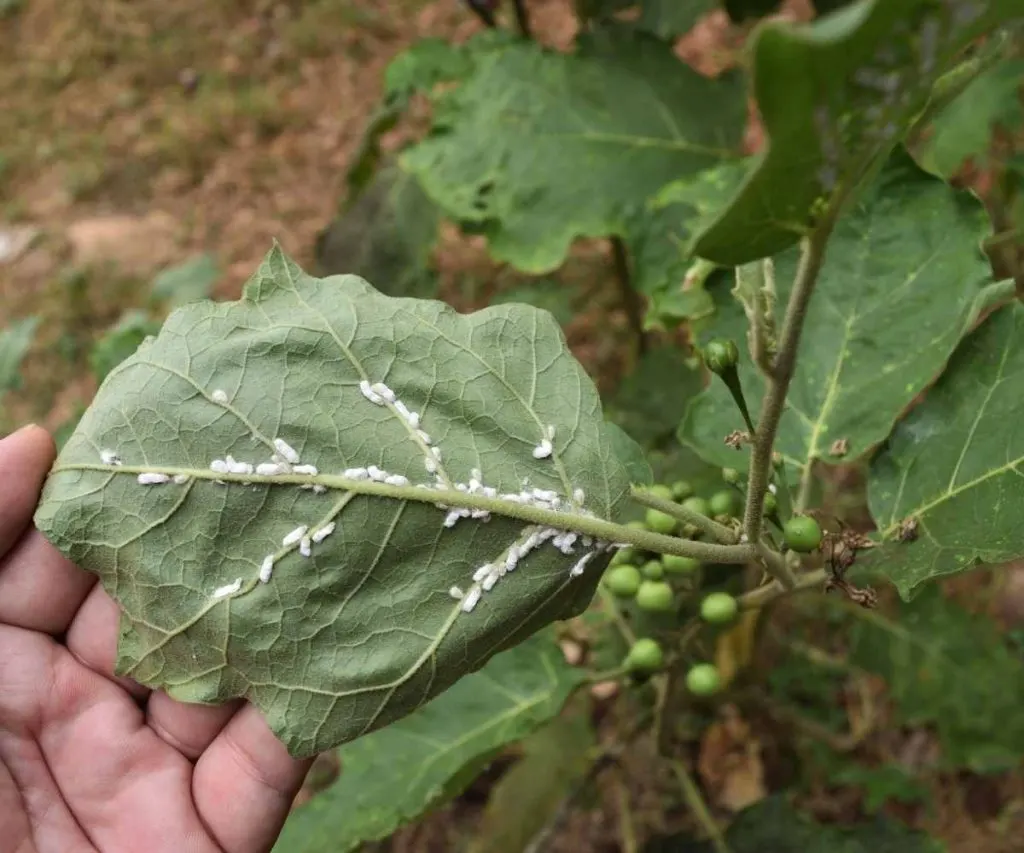
Mealies, like aphids and scale, secrete a sticky honeydew onto your plant leaves. If you see sticky shiny places on your leaves beware.
Honeydew can cause a grey sooty mold on plants. But worse, it attracts herd ants.

Herder Ants will farm nectar producing insects like Mealybugs, Aphids and Scale.
Ants LOVE honeydew and farm insects that secrete it. For more on herder ants and how they farm insects for honeydew read our post on How to get rid of Aphids.
If you see ants in your house, pay attention to what they are doing.
- Mealy bugs spread plant diseases from one plant to another. If you see plant diseases on your plant leaves popping up for no apparent reason, watch for mealy bugs, aphids, thrips and fungus gnats.
- Plants show mealybug damage as wilting and/or bleached leaves.
- The leaf can form holes with dried dead edges as you see pictured above.
- As the plant cells die the leaf can be deformed with brown spots.
- Also look for leaf drop, sooty mold, stunted growth, and eventually, if untreated, the death of the plant.
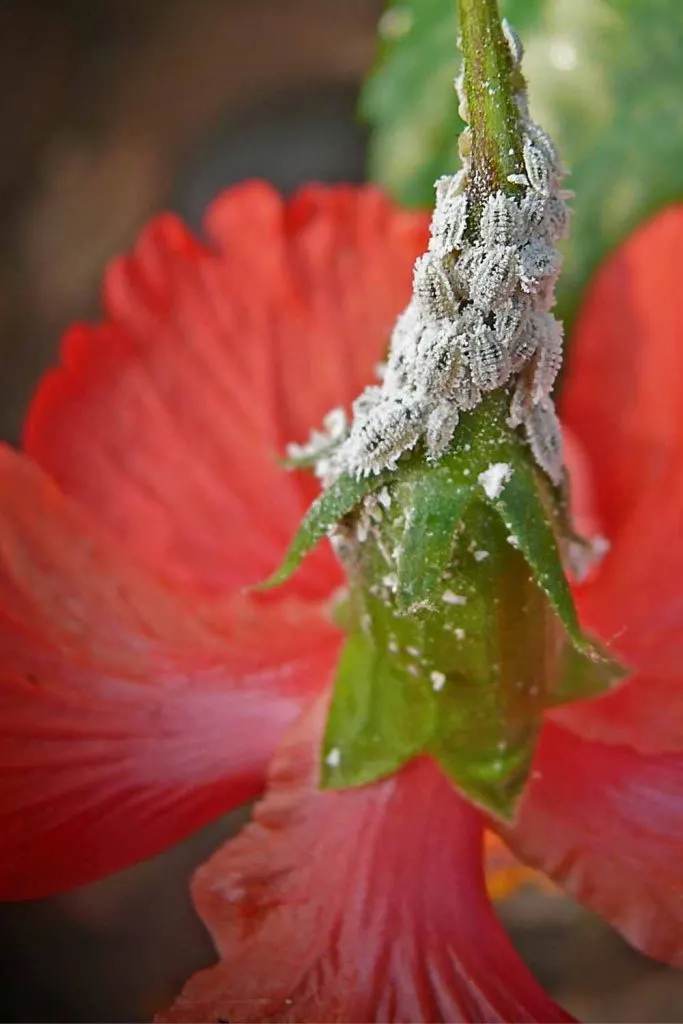
Mealy bugs set up house on any part of the plant. However they are especially fond of the delicate tender tissues of flowers. Look for them under your plant flower buds, in the new leaf whorls and even on woody stems of your plants.
NEVER compost plants with pests, molds and fungal infections. You will just spread these problems into your compost.
The Contented Plant
Mealybug Life Cycle:
The females lay several hundred eggs in one generation. The entire life cycle of mealybugs takes about a month to complete. You may see several life stage at once on your plant.
You want to stay well ahead of mealy bug invasions. Deal with them quickly and decisively.
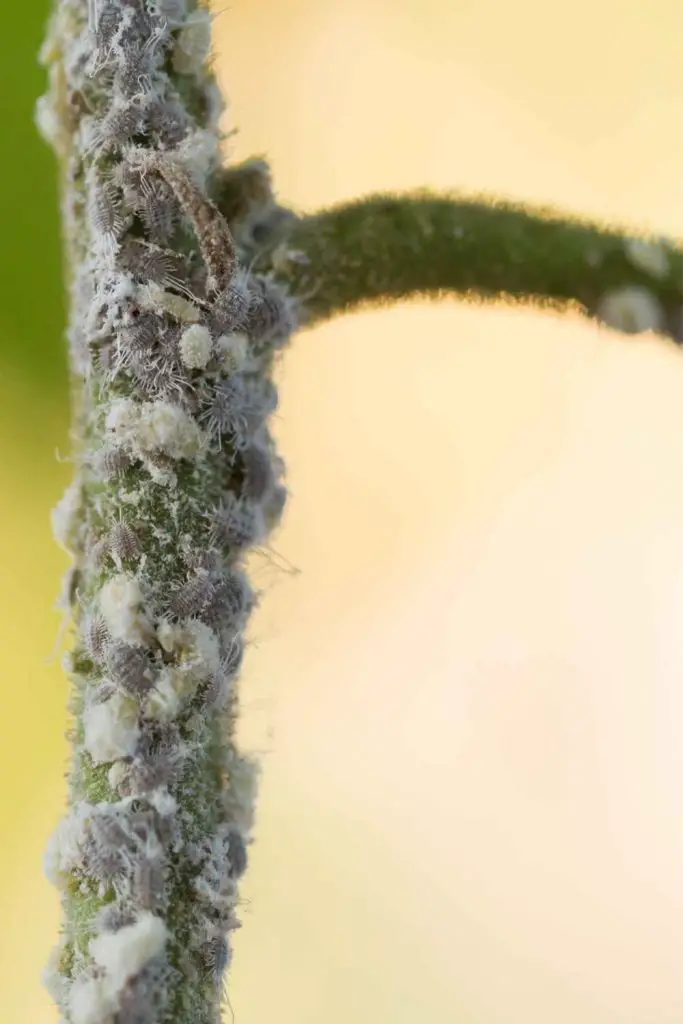
How To Safely Dispose Of Infested HousePlants:
If you see a LOT of pest damage and want to get rid of the plant rather than treat it, here’s the proper way to do it.
- Take the whole plant and set it in an airtight garbage bag.
- Seal the bag.
- Throw it into the garbage OUTSIDE.
- Do NOT throw a plant live with pests into your compost pile or anywhere they can continue their life cycle.
- Be sure to sterilize the home surfaces you and the plant came in contact with.
- Any other houseplants grouped together with the affected one should also be checked for pests and sprayed with a neem oil insecticidal spray.
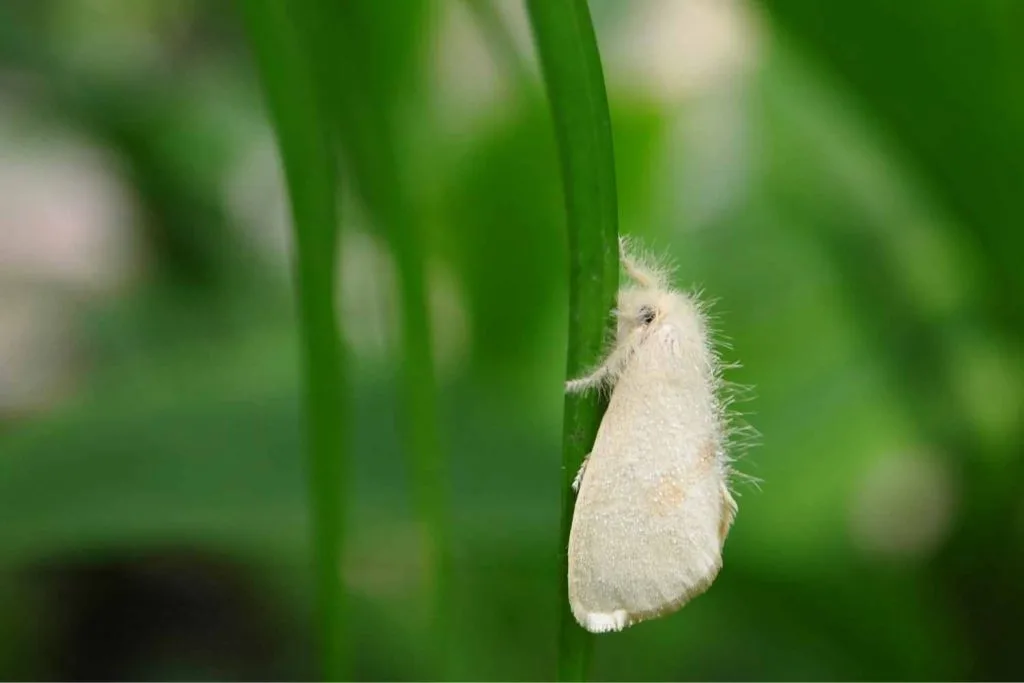
How to Keep Pests outside:
- Any new houseplants should be checked before purchase for plant pests.
- Quarantine all newly purchased houseplants from other plants at least a month.
- Plant pests can travel indoors on your cloths and even catch a breeze and fly into your home.
- Many pests such as thrips spider mites, whiteflies, aphids and mealybugs live on your outdoor plants and may get a foothold on your Indoor Plants. They come in on the wind, Cut outdoor flowers, and garden produce.
- Herder ants will also bring any honeydew producing pest indoors to set up house if they can. If you see an ant in your house or on a plant pay attention to what it is doing.
How to get rid of mealybugs on houseplants.
Once you see mealybugs or mealybug damage on your plant leaf stem or flower, act quickly! And expect at least two months of combat against these pests.
Like other sucking pests mealies are small and easy to miss. And they populate by the hundreds in each generation.
Since they also spread plant disease you may see signs of viral or bacterial infection on your plant and not immediately realize you also have the bugs.
You will need to treat for mealybugs at least weekly for two months after you initially eradicate them. Here are the most popular methods of killing and managing mealybugs on houseplants.
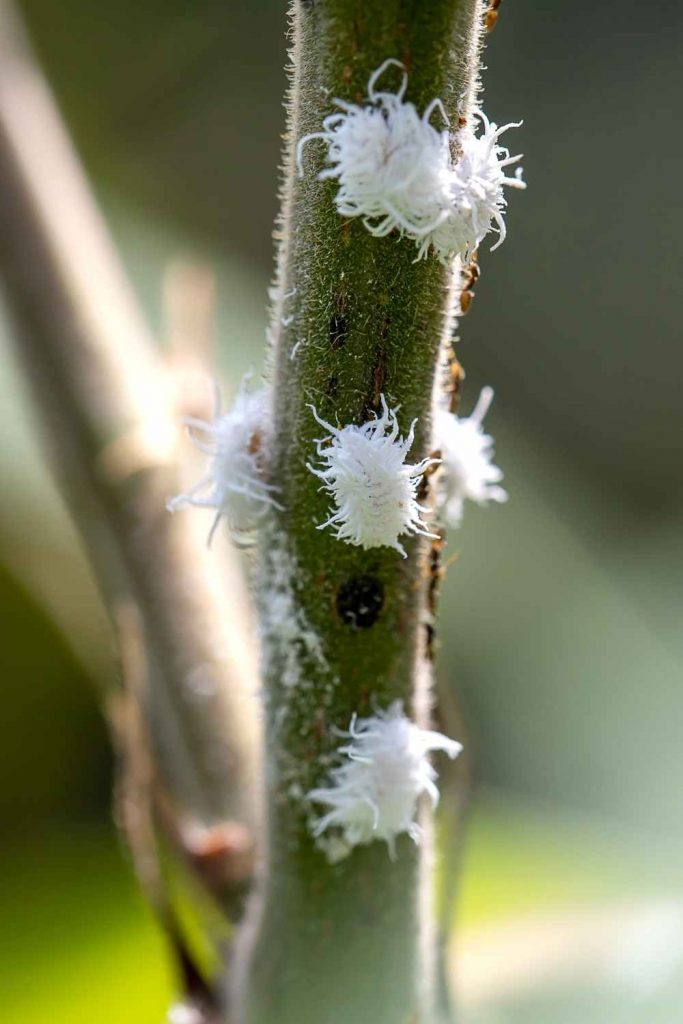
How to kill mealy bugs:
Manually hunt and destroy :
- You MUST hunt the mealy bugs down and destroy them. This means you closely examine your plants with a magnifying glass if you have one. This the magnifier I use.
- Manually remove the bugs and crush them. You can use a cloth immersed in neem oil and water to clean the bugs off your plant but you must actually kill them in all their life stages to kill the population.
- You will miss some. They live in crannies you can’t see or reach like leaf whorls. That is why you must follow up with the treatments below on a weekly basis.
- Regular leaf washing is also recommended with neem oil to help repel pests long term.
- Prune off the damaged leaves, flowers and stems of the affected plant.
- Spray the plant stem and top and bottom of the leaves with the neem oil spray. Get the spray into ALL the nooks and crannies of your plant.
- Isolate the plant away from other plants that it can infect until ALL two months are over and at least ONE month is pest free.
Neem oil:
- Neem oil is an excellent organic pest killer and repellent. Of all the methods of pest treatment and prevention. Neem oil sprays works best on houseplants.
- Spray neem oil on mealy bugs directly and then wipe off all signs of the bugs you can reach. This includes any sooty molds and all life stages of mealy bugs.
- A weekly or monthly wipe down of your plant leaves with Neem oil and water will help deter pests and keep your plant leaves healthy.
insecticidal sprays:
For indoor use on houseplants keep your insecticidal sprays organic. We also have a recipe in our How to card below for an insecticidal soap with neem oil that is highly effective.
70 % Rubbing Alcohol:
Dip a Q tip in the rubbing alcohol and directly apply it to the mealybugs in all life stages. Be sure to follow this up with a spray if you really want to get rid of mealybugs.
Diatomaceous Earth:
For the home use only food grade diatomaceous earth. Diatomaceous earth is like ground glass to most bugs that come in contact with it. You can mix this as a powder into the top layer of your soil like we do for fungus gnats. You can also mix it with water and create a drench. Pour this drench into the soul of your plant and it will weaken eventually kill off mealybugs and fungus gnat larvae both.
Natural Mealybug Predators:
We don’t recommend natural predators in your home. But if you have mealybugs in your ornamental plants, greenhouse or garden natural predators are very helpful.
Mealybug Destroyer (Cryptolaemus montrouzieri) is a very effective beneficial predator of mealy bugs. Most often used for outdoor gardens, commercial crops and greenhouses.
You can buy it online here. But don’t set them free in your home. This relative of the lady bug is a voracious killer of mealybugs. It loves warm climates. Mealybug destroyers cannot survive cold winters so must be reintroduced every spring for colder climates.
Green Lacewing bugs are a wonderful predator of aphids and mealy bugs.
There are many other predators of mealybugs including parasitoid wasps, hover fly larvae and more. Find the one that best suits your climate and conditions.
How To Safely Dispose Of Infested HousePlants:
If you see a LOT of pest damage and want to get rid of the plant rather than treat it, here’s the proper way to do it.
- Take the whole plant and set it in an airtight garbage bag.
- Seal the bag.
- Throw it into the garbage OUTSIDE.
- Do NOT throw a plant live with pests into your compost pile or anywhere they can continue their life cycle.
- Be sure to sterilize the home surfaces you and the plant came in contact with.
- Any other houseplants grouped together with the affected one should also be checked for pests and sprayed with a neem oil insecticidal spray.
Homemade Insecticidal Spray with Neem Oil:
Here’s how to get rid of mealybugs on plants with our homemade Pest spray recipe. Make our Insecticidal spray below and use it regularly for good results and longterm deterrence of all sorts of houseplant pests.
Homemade Insecticidal Soap Recipe
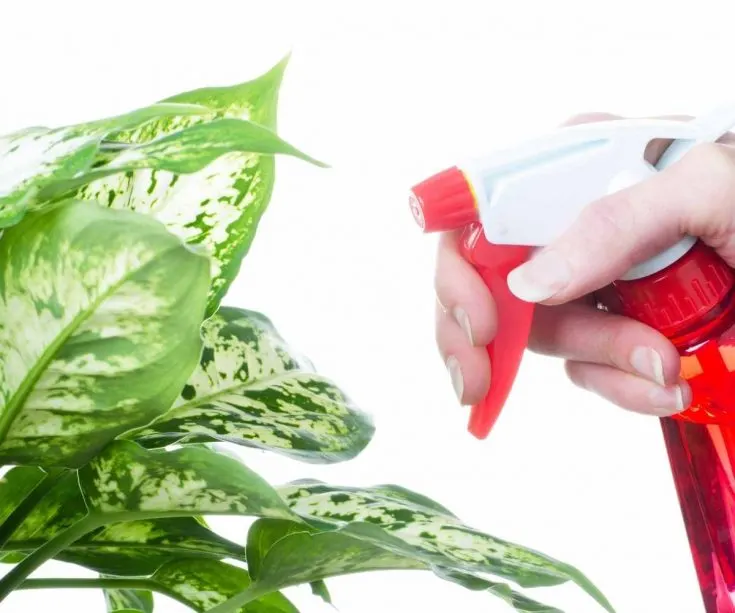
This Insecticidal Soap Spray Recipe with Neem oil is effective for spider mites, thrips, and soft-bodied insects on plants, such as aphids, young scales, whiteflies and mealybugs.
This recipe is Only a deterrent to caterpillars and beetle larvae. But this recipe will control boxelder bugs when they are still in the small nymph stages.
Materials
- 1 1/2 Tsp. Neem Oil
- 1/2 Teaspoon pure Castile liquid dish soap (or other organic liquid soap)]
- 1 quart water-soft or average hard water for best results.
- OPTIONAL:
- A few added drops of lavender, peppermint, or orange oil
Instructions
- mix the water, neem oil and soap into a solution.
- Pour solution into the spray bottle.
- spray on the affected plant leaves on the top and bottom.
- Also spray stems, intersections and buds of flowers.
- Leave the solution on the plants overnight.
- Spray the plants with water after 12 hours or so to rinse the leaves and remove dead pests.
- Reapply as needed. To interrupt the pest life cycle spray every three days for two weeks.
Although the basic recipe will work as described you may wish to enhance your formula by adding
A few added drops of lavender, peppermint, or orange oil in this recipe will help repel pests and smells great!
Notes
Sensitivity of Plants:
We do NOT recommend liquid dish soap DETERGENTS such as Dawn for this recipe. They contain harsh chemicals that can harm the surface of the plant leaves.
If you find this recipe is too harsh and burns your plants. Cut the soap amount in half or follow this spray with an immediate spray of plain water to protect your plant leaves. Also sensitive plants like ferns, succulents, azaleas and waxy leaved plants may be harmed by this spray.
Water Hardness matters:
This recipe is most effective with average to soft water. A hard water will yield a less effective insecticidal spray recipe and can leave soap scum on your plant leaves.
How to use this Spray:
- DIY Organic Insecticidal Soap Recipe works on contact which means it must coat the insect to kill it.
- This spray has No residual effect and must be applied several times at weekly intervals for best control. Although neem oil has some lasting impact on insects most of the effectiveness of this spray is by direct contact.
- Spray the entire plant with special focus on those areas of your plant where you can find the bugs.
- Spray in the morning or evening in cooler temperatures and when plants are shaded. You want the spray to last. Once it dries the spray is ineffective.
Go to our Homemade Food Junkie article For more on this recipe
The cost of this recipe is determined by which soap you use and if you have to purchase a spray bottle.
This insecticidal soap is not effective on fungus gnats. Read this article on how to kill and manage Fungus Gnats
Follow Us:
Find us on YouTube, Instagram , Pinterest and TikTok! We love to Plant chat. We also comment, like and occasionally share your content to our daily stories. We’d love to see your plants. Share your joy in your houseplants. Happy Planting!
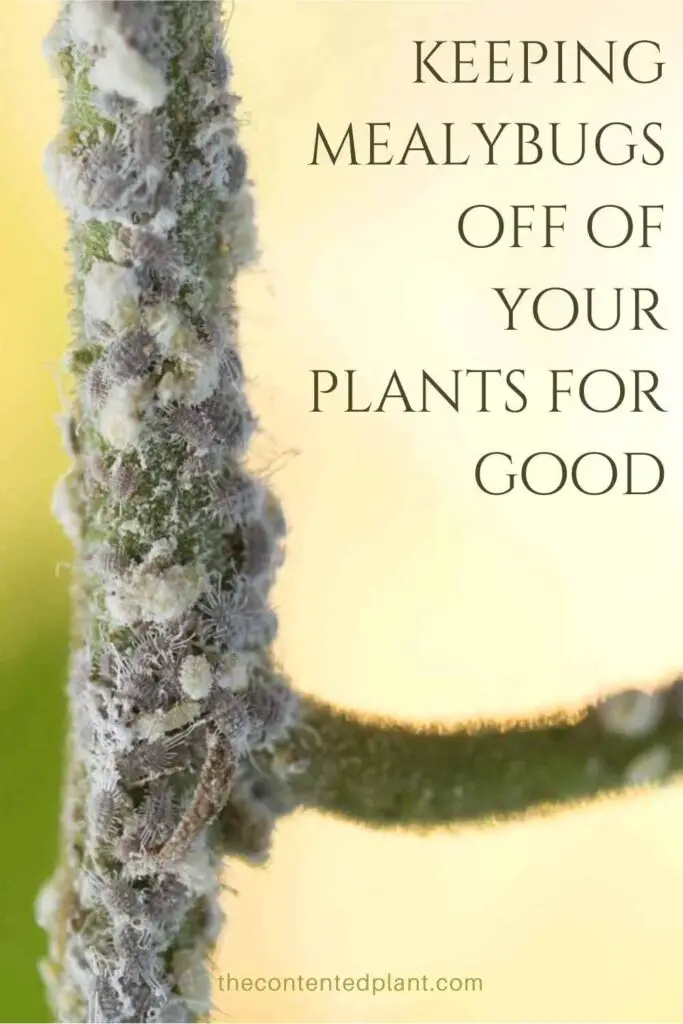

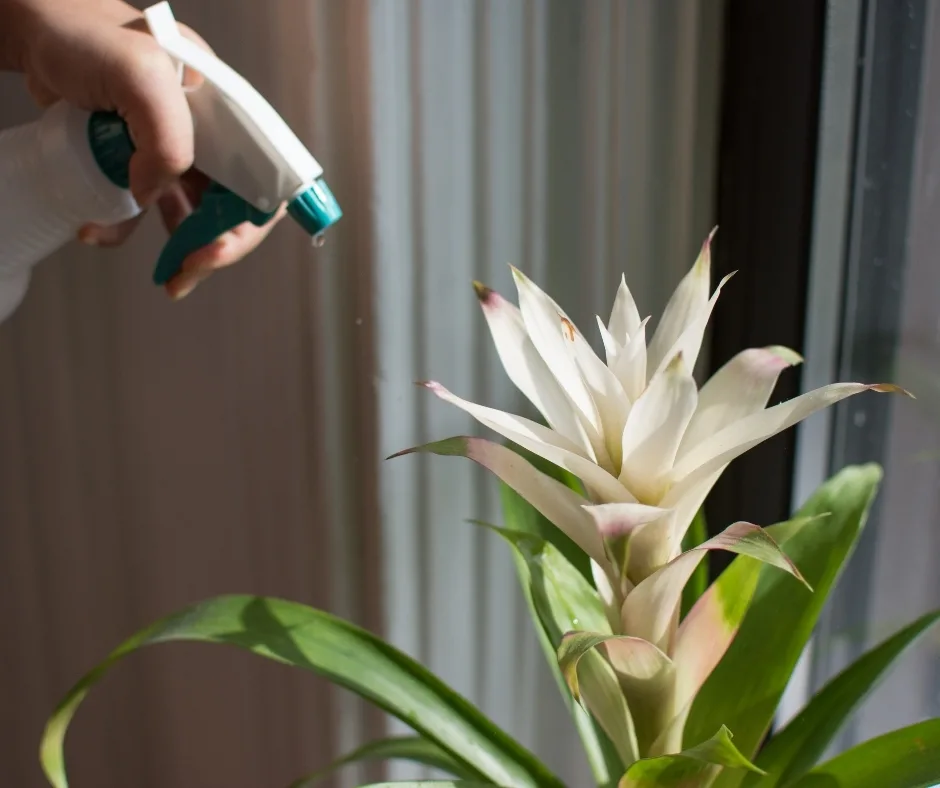
Parodia leninghausii - The Contented Plant
Tuesday 27th of June 2023
[…] for common cactus pests like mealybugs, aphids or […]
Epipremnum Pinnatum: Dragons Tail - The Contented Plant
Monday 6th of February 2023
[…] Dragons tail pothos are susceptible to common houseplant pests such as spider mites and mealybugs. Keep an eye out for small webs or white cottony spots on the leaves and treat promptly if […]
Cat Palm - The Contented Plant
Wednesday 28th of December 2022
[…] Mealybugs: These are small, soft-bodied insects that can infest the leaves and stems of cat palms. They can be identified by the white, cottony substance they produce, which is actually a protective covering for their eggs. Mealybugs can cause yellowing and wilting of the leaves and can weaken the plant if left uncontrolled. […]
How to Get Rid of Spider Mites on Plants - The Contented Plant
Tuesday 26th of April 2022
[…] mites are sucking insects like Thrips, Aphids and Mealybugs. They attach themselves to plant cells and suck out the juices. The leaf cell dies eventually and […]
Snake Plant Watering Guide - The Contented Plant
Sunday 16th of January 2022
[…] stress contributes to poor top growth, root rot and infestations of pests. Spider mites and mealy bugs are the two plant pests most likely to set up house on a stressed out […]